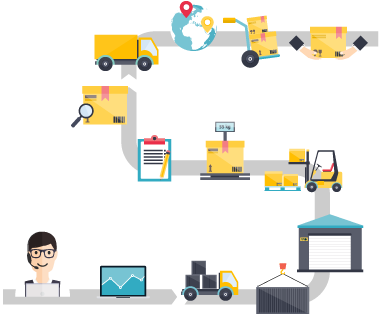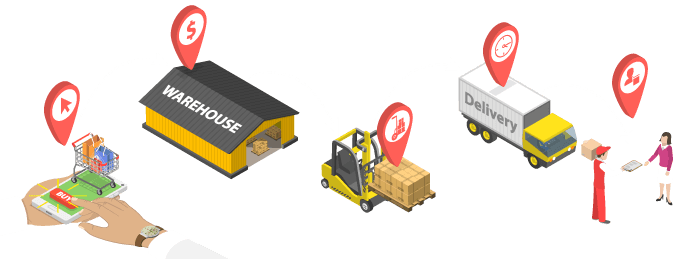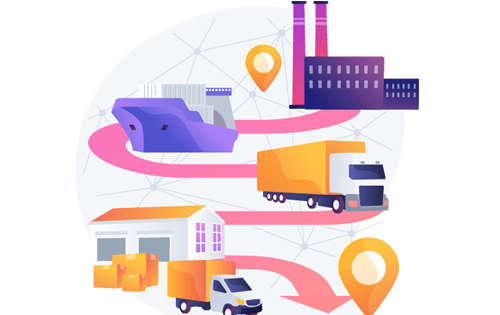What is Distribution Management?
Built For


Discover how distribution management significantly impacts a business’ efficiency and customer satisfaction.
Getting the right products to the right customers at the right time is crucial. This is where distribution management comes into play. But what exactly is distribution management, and why is it so important for businesses? Whether running a small online business or managing a large distribution enterprise, understanding distribution management significantly impacts your efficiency and customer satisfaction.
In this article, we’ll explore the world of distribution management and its essential components and discuss how effective distribution strategies can give your business a competitive edge. From managing inventory and processing orders to ensuring excellent customer service, we’ll cover all the essentials you need to know. So, let’s get started and see how mastering distribution management can drive success for your business.
What is Distribution Management?
Distribution management is the process of managing the flow of goods from a manufacturer or supplier to the end customer. It involves coordinated activities to ensure products are delivered efficiently, cost-effectively, and in perfect condition. This process is a critical component of the supply chain, directly impacting customer satisfaction, operational costs, and overall business performance.
At its core, distribution management focuses on optimizing the flow of goods. This includes managing inventory levels, processing orders, warehousing products, coordinating transportation, and providing excellent customer service. The goal is to create a seamless and efficient system that meets customer demands while minimizing costs and maximizing profitability.
Key objectives of distribution management include:
- Ensuring Timely Delivery: Ensure products reach customers within the expected time frame.
- Maintaining Product Quality: Ensuring products are stored and handled properly to prevent damage or spoilage.
- Optimizing Costs: Reducing transportation, storage, and operational costs without compromising service quality.
- Improving Customer Satisfaction: Providing reliable and accurate deliveries to enhance the customer experience.
- Enhancing Supply Chain Visibility: Using technology and data to control and track the movement of goods in real time.
Effective distribution management requires a strategic approach and technology to coordinate and streamline various activities. By doing so, businesses achieve a competitive advantage and meet their customers’ ever-increasing expectations.
Components of Distribution Management
Effective distribution management involves various interconnected components working together to ensure products move smoothly from the manufacturer to the customer.

Inventory Management
Inventory management involves controlling and overseeing the stock of goods. This involves tracking inventory levels, managing stock locations, and ensuring enough inventory is available to meet customer demand without overstocking. Effective inventory management helps reduce holding costs and minimize stockouts, which can lead to lost sales.
Order Processing
Order processing is the workflow from receiving an order to delivering it to the customer. This includes order entry, order fulfillment, and order tracking. Efficient order processing ensures customer orders are accurately recorded, picked, packed, and shipped promptly. It also involves handling returns and exchanges.
Warehousing
Warehousing involves storing goods to make them easily accessible for picking and packing. Warehouses are essential for managing large volumes of inventory and ensuring that the stock is stored securely and safely. Effective warehousing strategies include organizing products for efficient retrieval, using barcoding to streamline processes, and maintaining optimal storage conditions to preserve product quality.
Transportation
Transportation is the movement of items from one location to another. This can include shipping products from the manufacturer to the warehouse and from the warehouse to the customer. Effective transportation management involves selecting the best carriers, ensuring timely deliveries, and minimizing transportation costs.
Customer Service
Customer service in distribution management ensures customers are satisfied with their orders. This includes providing accurate information about order status, handling inquiries and complaints promptly, resolving any issues related to delivery, and handling returns if necessary. Excellent customer service can enhance customer loyalty and lead to repeat business.
Each component plays a role in a successful distribution management. Businesses improve efficiency, reduce costs, and deliver a better customer experience by optimizing each element.
Benefits of Effective Distribution Management
Effective distribution management offers numerous advantages that can significantly impact a business’s performance and customer satisfaction.
Improved Customer Satisfaction
When products are delivered accurately and on time, customer satisfaction naturally increases. Effective distribution management ensures customers receive their orders when expected and in good condition, fostering loyalty and trust. Satisfied customers become repeat buyers and recommend your business to others.
Cost Efficiency

Effective distribution management leads to substantial cost savings by optimizing inventory levels, reducing transportation costs, and streamlining warehousing operations. Efficient order processing and reduced waste further contribute to a leaner, more cost-effective operation.
Enhanced Supply Chain Visibility
With distribution management systems and real-time tracking technologies, businesses gain greater visibility into their supply chain. This allows for better decision-making, quicker identification of issues, and more effective coordination among various stakeholders. Enhanced visibility ensures that all parts of the distribution process run smoothly and can be adjusted to meet changing demands.
Faster Delivery Times
Streamlined distribution processes result in quicker order fulfillment and delivery. By improving warehouse efficiency, businesses reduce the time it takes for products to reach customers. Faster delivery times can be a significant competitive advantage, especially in industries where timely delivery is crucial.
Better Inventory Control
Effective distribution management involves precise inventory tracking and management, which helps maintain optimal stock levels. This prevents overstocking and stockouts, ensuring products are available when customers need them. Better inventory control lowers holding costs and reduces the risk of obsolete or expired products.
Increased Flexibility
A well-managed distribution system quickly adapts to demand fluctuations, market conditions, and other external factors that allow companies to respond swiftly to customer needs and unexpected disruptions.
Improved Collaboration
Effective distribution management fosters better collaboration and communication among different parts of the supply chain, including suppliers, manufacturers, warehouses, and transportation providers. Improved cooperation ensures all parties are aligned and working towards common goals, resulting in a more efficient and cohesive distribution process.
Competitive Advantage
By excelling in distribution management, businesses can differentiate themselves from competitors. Superior distribution capabilities can become a crucial selling point, attracting more customers and gaining market share. A reputation for reliable and efficient delivery can set a business apart in a crowded marketplace.
Effective distribution management enhances operational efficiency, reduces costs, and improves customer satisfaction. By optimizing all distribution aspects, businesses can achieve significant advantages that contribute to long-term success.
Challenges in Distribution Management
While effective distribution management brings numerous benefits, it also comes with challenges. Understanding the challenges is crucial for developing strategies to overcome them and ensuring a smooth distribution process.
Managing Demand Fluctuations
One of the biggest challenges in distribution management is dealing with fluctuations in demand. Predicting customer demand accurately can be difficult, and unexpected surges or drops in orders can disrupt the entire supply chain. Overestimating demand leads to excess inventory and increased holding costs while underestimating demand can result in stockouts and lost sales.
Coordinating with Multiple Stakeholders
Distribution management involves coordinating with various stakeholders, including suppliers, manufacturers, warehouses, transportation providers, and customers. Ensuring seamless communication and collaboration among all these parties can be challenging. Miscommunications or delays in information sharing can lead to inefficiencies, errors, and delays in the distribution process.
Ensuring Timely Delivery

Customers expect quick delivery of their orders and any delays can negatively impact customer satisfaction. Managing timely delivery involves optimizing transportation routes, dealing with traffic and weather-related disruptions, and coordinating with multiple carriers. Ensuring all these elements work together seamlessly to meet delivery deadlines can be challenging.
Maintaining Cost-Effectiveness
Balancing cost efficiency with high service levels is a constant challenge in distribution management. Transportation, warehousing, and inventory holding costs can add up quickly, and finding ways to minimize these expenses without compromising on service quality requires continuous effort and optimization.
Handling Returns and Exchanges
Managing returns and exchanges can be complex and costly. An inventory and order management system with return merchandise authorization (RMA) tracking capabilities is needed to handle returned products efficiently, restock or dispose of them appropriately, and process refunds or exchanges. Handling returns smoothly is essential for maintaining customer satisfaction but can add complexity to distribution management.
Employing Technology
Keeping current with the latest technology advancements, such as inventory management software, real-time tracking, and data analytics is a must for high-performing distribution management companies, ensuring they continuously improve and evolve.
Managing Global Supply Chains
For businesses operating globally, managing international distribution adds another level of complexity. Dealing with different regulations, customs procedures, tariffs, and logistical challenges across various countries can be daunting. Ensuring consistency and efficiency in global distribution requires careful planning, coordination, and the use of technology.
Ensuring Product Quality
Maintaining product quality throughout the distribution process is crucial. Products can get damaged during storage, handling, or transportation, leading to dissatisfied customers and increased returns. Implementing stringent quality control measures, such as traceability, and ensuring proper packaging and handling practices can help mitigate this challenge but requires constant vigilance.
Understanding these challenges and proactively addressing them is essential for effective distribution management. By developing strategies to mitigate these issues, businesses can ensure a smoother distribution process and maintain a competitive edge in the market.
Strategies for Successful Distribution Management
To overcome distribution management challenges, businesses need to implement effective strategies.
Leveraging Inventory, Order, and Distribution Management Software

Investing in a software solution for inventory, order, and distribution management significantly enhances efficiency and accuracy and provides real-time visibility into inventory levels, order statuses, and distribution activities. Inventory software automate processes, reduces manual errors, and optimizes resource utilization. By leveraging technology, businesses can make data-driven decisions, streamline operations, and improve overall performance.
Streamlining Order Processing from All Channels Through Order Consolidation
With the rise of multi-channel retailing, managing orders from various sales channels can be complex. Implementing order consolidation strategies streamlines order processing by combining orders from different channels into a single workflow. This reduces duplication, minimizes handling errors, and ensures consistent order fulfillment. By consolidating orders, businesses improve efficiency, reduce processing times, and provide a seamless customer experience across all channels.
Utilizing Real-Time Tracking and Monitoring
Real-time tracking of goods throughout the distribution process is crucial for ensuring timely deliveries and maintaining visibility. This helps identify potential delays or issues promptly, enabling proactive problem-solving. Real-time tracking also provides customers accurate delivery information, enhancing their satisfaction and trust.
Enhancing Communication and Collaboration
Effective collaboration and good communication in the distribution process are essential for smooth operations. Implementing unified platforms and communication tools facilitate better information sharing and coordination ensuring everyone is on the same page, reducing misunderstandings and delays.
Implementing Data Analytics for Decision Making
Using data analytics to gain insights into distribution performance helps optimize processes and identify areas for improvement. Analyzing order patterns, delivery times, and inventory levels allows companies to make informed decisions and anticipate future needs. Predictive analytics assists with forecasting demand and optimizing inventory quantities, ensuring products are available when and where they are needed.
Optimizing Transportation and Logistics
Efficient transportation and logistics management are critical for successful distribution. This involves selecting suitable carriers and consolidating shipments to reduce costs and improve delivery times.
Focusing on Continuous Improvement
Continuous improvement is vital to maintaining an efficient and effective distribution management system. Regularly reviewing and analyzing distribution processes, seeking stakeholder feedback, and staying updated with industry best practices can drive ongoing improvements. Implementing lean practices and eliminating waste and inefficiencies can further enhance distribution performance.
By adopting these strategies, businesses achieve successful distribution management, ensuring that products are delivered to customers efficiently, accurately, and cost-effectively. This enhances customer satisfaction and contributes to overall business growth and competitiveness.
Distribution Management FAQs
What is distribution management?
Distribution management involves managing inventory, processing orders, warehousing products, coordinating transportation, and providing excellent customer service to ensure products are delivered to customers efficiently and cost-effectively.
Why is distribution management important for businesses?
Effective distribution management is crucial for ensuring timely product delivery, maintaining product quality, reducing operational costs, improving customer satisfaction, and enhancing overall supply chain visibility. Distribution management helps businesses meet customer demands, minimize costs, and gain a competitive edge.
What are the key components of distribution management?
The key components of distribution management include inventory management, order processing, warehousing, transportation, and customer service. Each element ensures that products are stored, handled, and delivered efficiently.
What are some common challenges in distribution management?
Common challenges in distribution management include managing demand fluctuations, coordinating with multiple stakeholders, ensuring timely delivery, maintaining cost-effectiveness, handling returns and exchanges, adapting to technological changes, managing global supply chains, and ensuring product quality.
How can businesses improve their distribution management processes?
Businesses can improve their distribution management processes by leveraging inventory, order, and distribution management software, streamlining order processing through order consolidation, utilizing real-time tracking and monitoring, enhancing communication and collaboration, implementing data analytics for decision-making, and focusing on continuous improvement.
What are the benefits of effective distribution management?
The benefits of effective distribution management include improved customer satisfaction, cost efficiency, enhanced supply chain visibility, faster delivery times, better inventory control, increased flexibility, improved collaboration, and a competitive advantage in the market.
Call us at 817-870-1311





